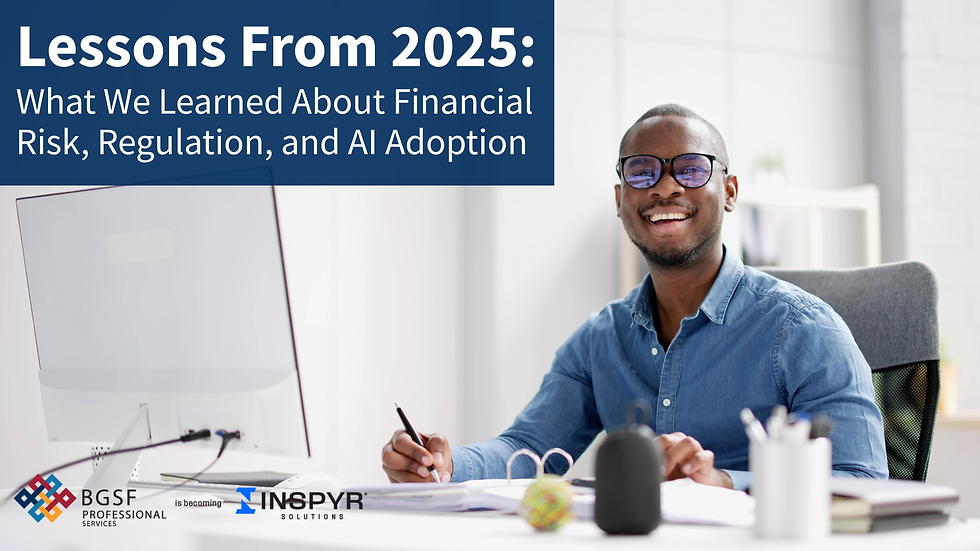Lessons From 2025: What We Learned About Financial Risk, Regulation, and AI Adoption
- bberrodin
- 2 hours ago
- 3 min read

2025 was a defining year for finance and accounting teams. Market volatility, shifting regulatory expectations, and rapid advances in AI forced organizations to rethink long-standing processes and modernize faster than planned. As we approach 2026, leaders across industries are already asking the same question: What did 2025 teach us and how do we apply those lessons now?
Below are the key takeaways that shaped financial operations this year, along with practical strategies businesses can use to strengthen stability, compliance, and performance in the year ahead.
Financial Lessons from 2025
1. Financial Risk Became More Real-Time and More Complex
Markets moved faster in 2025 than many organizations were prepared for. Interest rate unpredictability, supply chain disruptions, and extreme weather events placed pressure on cash flow, forecasting accuracy, and operational resilience.
What we learned:
Static annual or quarterly forecasting is no longer enough.
Scenario modeling is becoming a core competency for finance teams.
Companies with real-time visibility into working capital made stronger decisions during volatility.
What to do next:
Adopt rolling forecasts and near-real-time financial dashboards.
Strengthen risk frameworks to account for operational risks, not just financial ones.
Lean on external staffing support during peak reconciliation or forecasting cycles to avoid burnout and maintain execution quality.
2. Regulation Tightened, Especially Around ESG and Data Governance
Regulators in North America accelerated efforts to standardize environmental, social, and governance (ESG) reporting while also increasing scrutiny on data accuracy and internal controls.
Key regulatory themes from 2025:
ESG disclosures moved from “nice to have” to “expected,” especially for organizations with large real estate, supply chain, or global footprints.
Data protection and audit trails became central to compliance, not just security.
Internal controls were tested at a higher level, particularly for companies undergoing technology transformations.
What we learned:
Organizations that waited to react were forced into expensive last-minute scrambles.
Those that invested early in data cleanliness and governance had smoother audits and avoided compliance gaps.
What to do next:
Prioritize centralized data governance to support both ESG and financial reporting.
Build compliance-readiness into every technology project.
Use interim accounting and audit talent to support year-end testing, documentation, and implementation.
3. AI Adoption Accelerated, But Not Evenly
If 2024 was the year of AI excitement, 2025 was the year of AI pressure. CFOs, controllers, and audit leaders all faced the expectation to modernize while simultaneously navigating concerns around accuracy, transparency, and job disruption.
What we learned:
Early adopters gained productivity quickly, especially in reconciliations, data entry, and reporting preparation.
Many organizations struggled to distinguish between AI hype and operational value.
AI governance became just as important as AI tools.
Winning strategies that emerged:
Start small with high-volume, rule-based processes.
Prioritize human-in-the-loop oversight.
Connect your AI roadmap to actual business outcomes, not trend-driven adoption.
Use project-based or fractional experts to fill AI-related skill gaps during transitions.
4. Finance Talent Needs Shifted—And Skills Gaps Widened
With risk, regulation, and AI in motion simultaneously, finance teams experienced one of the fastest competency shifts in years.
What we learned:
Financial analysts needed stronger data storytelling skills.
Accounting teams needed both technical depth and digital fluency.
Cross-functional collaboration became essential in implementing AI, ESG reporting tools, and modern ERP systems.
But 2025 also exposed a persistent challenge: many organizations lacked the specialized talent to keep up.
What to do next:
Upskill teams around analytics tools, ESG data requirements, and AI-assisted workflows.
Reevaluate job roles. Many finance positions now require both accounting fundamentals and systems expertise.
Engage external experts to bridge role gaps during system upgrades, audit pressures, or regulatory shifts.
5. Organizations That Invested Early in Modernization Saw the Best Outcomes
Across industries, a clear pattern emerged: companies that modernized earlier, implementing AI, improving governance, strengthening controls, and developing adaptable staffing strategies, navigated 2025 more smoothly.
Top-performing organizations:
Used AI to reduce manual workload and refocus staff on higher-value analysis.
Built flexible workforce models to respond quickly to market and regulatory changes.
Strengthened financial visibility for faster, more informed decisions.
Those who waited paid more in the long run, through compliance issues, slower closes, greater overtime, and stalled transformation programs.
Proactive Financial Resilience
2025 reminded us that financial resilience isn’t built on reacting; it’s built on preparing. Organizations that invested in stronger data foundations, adaptable processes, and the right mix of human expertise and technology were the ones able to navigate uncertainty with confidence. As 2026 approaches, the leaders who will excel are those who stay proactive, embrace innovation responsibly, and ensure their teams have the support they need to execute.
BGSF Professional Services is becoming INSPYR Solutions: We provide flexible, on-demand finance and accounting expertise to help you enter 2026 with a clear financial foundation. Contact us today!



Comments